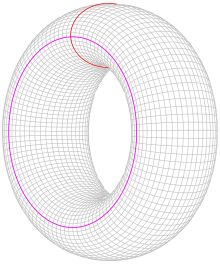Diferencia entre revisiones de «Simetría especular (teoría de cuerdas)»
Apariencia
Contenido eliminado Contenido añadido
Traducido de en:Mirror symmetry (string theory), exactamente la versión https://en.wikipedia.org/w/index.php?title=Mirror_symmetry_(string_theory)&oldid=680613477, bajo licencia GFDL y CC-BY-SA 3.0 |
(Sin diferencias)
|
Revisión del 17:35 26 sep 2015
En geometría algebraica y física teórica simetría especular es una relación entre objetos geométricos llamados Variedad de Calabi-Yau . El término se refiere a una situación en la que dos variedades de Calabi-Yau se ven muy diferentes geométricamente, pero son sin embargo equivalentes cuando se emplea las dimensiones extras de la teoría de cuerdas.
Información general
Cuerdas y compactación

Variedades de Calabi-Yau

Historia
Aplicaciones
Geometría enumerativa


Física teórica
Enfoques
Simetría especular homológica

Conjetura Strominger-Yau-Zaslow

Véase también
Notas
Referencias
- Aspinwall, Paul; Bridgeland, Tom; Craw, Alastair; Douglas, Michael; Gross, Mark; Kapustin, Anton; Moore, Gregory; Segal, Graeme; Szendröi, Balázs; Wilson, P.M.H., eds. (2009). Dirichlet Branes and Mirror Symmetry. American Mathematical Society. ISBN 978-0-8218-3848-8.
- Candelas, Philip; de la Ossa, Xenia; Green, Paul; Parkes, Linda (1991). «A pair of Calabi–Yau manifolds as an exactly soluble superconformal field theory». Nuclear Physics B 359 (1): 21-74. Bibcode:1991NuPhB.359...21C. doi:10.1016/0550-3213(91)90292-6.
- Candelas, Philip; Horowitz, Gary; Strominger, Andrew; Witten, Edward (1985). «Vacuum configurations for superstrings». Nuclear Physics B 258: 46-74. Bibcode:1985NuPhB.258...46C. doi:10.1016/0550-3213(85)90602-9.
- Candelas, Philip; Lynker, Monika; Schimmrigk, Rolf (1990). «Calabi–Yau manifolds in weighted ». Nuclear Physics B 341 (1): 383-402. Bibcode:1990NuPhB.341..383C. doi:10.1016/0550-3213(90)90185-G.
- Dixon, Lance (1988). «Some world-sheet properties of superstring compactifications, on orbifolds and otherwise». ICTP Ser. Theoret. Phys. 4: 67-126. ISBN 978-9971-5-0452-6.
- Givental, Alexander (1996). «Equivariant Gromov-Witten invariants». International Mathematics Research Notices 1996 (13): 613-663. doi:10.1155/S1073792896000414.
- Givental, Alexander (1998). «A mirror theorem for toric complete intersections». Topological field theory, primitive forms and related topics: 141-175. ISBN 978-1-4612-6874-1. doi:10.1007/978-1-4612-0705-4_5.
- Greene, Brian (2000). The Elegant Universe: Superstrings, Hidden Dimensions, and the Quest for the Ultimate Theory. Random House. ISBN 978-0-9650888-0-0.
- Greene, Brian; Plesser, Ronen (1990). «Duality in Calabi–Yau moduli space». Nuclear Physics B 338 (1): 15-37. Bibcode:1990NuPhB.338...15G. doi:10.1016/0550-3213(90)90622-K.
- Hori, Kentaro; Katz, Sheldon; Klemm, Albrecht; Pandharipande, Rahul; Thomas, Richard; Vafa, Cumrun; Vakil, Ravi; Zaslow, Eric, eds. (2003). Mirror Symmetry. American Mathematical Society. ISBN 0-8218-2955-6.
- Hori, Kentaro; Vafa, Cumrun (2000). «Mirror Symmetry». .
- Intriligator, Kenneth; Seiberg, Nathan (1996). «Mirror symmetry in three-dimensional gauge theories». Physics Letters B 387 (3): 513-519. Bibcode:1996PhLB..387..513I. arXiv:hep-th/9607207. doi:10.1016/0370-2693(96)01088-X.
- Kikkawa, Keiji; Yamasaki, Masami (1984). «Casimir effects in superstring theories». Physics Letters B 149 (4): 357-360. Bibcode:1984PhLB..149..357K. doi:10.1016/0370-2693(84)90423-4.
- Kontsevich, Maxim (1995a), «Enumeration of Rational Curves Via Torus Actions», The Moduli Space of Curves, Birkhäuser, p. 335, ISBN 978-1-4612-8714-8, doi:10.1007/978-1-4612-4264-2_12.
- Kontsevich, Maxim (1995b). «Homological algebra of mirror symmetry». Proceedings of the International Congress of Mathematicians: 120-139. Bibcode:1994alg.geom.11018K. arXiv:alg-geom/9411018.
- Lerche, Wolfgang; Vafa, Cumrun; Warner, Nicholas (1989). «Chiral rings in superconformal theories». Nuclear Physics B 324 (2): 427-474. Bibcode:1989NuPhB.324..427L. doi:10.1016/0550-3213(89)90474-4.
- Lian, Bong; Liu, Kefeng; Yau, Shing-Tung (1997). «Mirror principle, I». Asian Journal of Math 1: 729-763. Bibcode:1997alg.geom.12011L. arXiv:alg-geom/9712011.
- Lian, Bong; Liu, Kefeng; Yau, Shing-Tung (1999a). «Mirror principle, II». Asian Journal of Math 3: 109-146. Bibcode:1999math......5006L. arXiv:math/9905006.
- Lian, Bong; Liu, Kefeng; Yau, Shing-Tung (1999b). «Mirror principle, III». Asian Journal of Math 3: 771-800. Bibcode:1999math.....12038L. arXiv:math/9912038.
- Lian, Bong; Liu, Kefeng; Yau, Shing-Tung (2000). «Mirror principle, IV». Surveys in Differential Geometry: 475-496. Bibcode:2000math......7104L. arXiv:math/0007104.
- Mac Lane, Saunders (1998). Categories for the Working Mathematician. ISBN 978-0-387-98403-2.
- Moore, Gregory (2005). «What is ... a Brane?» (PDF). Notices of the AMS 52: 214. Consultado el June 2013.
- Sakai, Norisuke; Senda, Ikuo (1986). «Vacuum energies of string compactified on torus». Progress of Theoretical Physics 75 (3): 692-705. Bibcode:1986PThPh..75..692S. doi:10.1143/PTP.75.692.
- Strominger, Andrew; Yau, Shing-Tung; Zaslow, Eric (1996). «Mirror symmetry is T-duality». Nuclear Physics B 479 (1): 243-259. Bibcode:1996NuPhB.479..243S. arXiv:hep-th/9606040. doi:10.1016/0550-3213(96)00434-8.
- Vafa, Cumrun (1992). «Topological mirrors and quantum rings». Essays on mirror manifolds: 96-119. Bibcode:1991hep.th...11017V. ISBN 978-962-7670-01-8. arXiv:hep-th/9111017.
- Wald, Robert (1984). General Relativity. University of Chicago Press. ISBN 978-0-226-87033-5.
- Witten, Edward (1990). «On the structure of the topological phase of two-dimensional gravity». Nuclear Physics B 340 (2–3): 281-332. Bibcode:1990NuPhB.340..281W. doi:10.1016/0550-3213(90)90449-N.
- Witten, Edward (1992). «Mirror manifolds and topological field theory». Essays on mirror manifolds: 121-160. ISBN 978-962-7670-01-8.
- Yau, Shing-Tung; Nadis, Steve (2010). The Shape of Inner Space: String Theory and the Geometry of the Universe's Hidden Dimensions. Basic Books. ISBN 978-0-465-02023-2.
- Zaslow, Eric (2008). «Mirror Symmetry». En Gowers, Timothy, ed. The Princeton Companion to Mathematics. ISBN 978-0-691-11880-2.
- Zwiebach, Barton (2009). A First Course in String Theory. Cambridge University Press. ISBN 978-0-521-88032-9.
Otras lecturas
Popularizaciones
- Yau, Shing-Tung; Nadis, Steve (2010). The Shape of Inner Space: String Theory and the Geometry of the Universe's Hidden Dimensions. Basic Books. ISBN 978-0-465-02023-2.
- Zaslow, Eric (2005). «Physmatics». .
- Zaslow, Eric (2008). «Mirror Symmetry». En Gowers, Timothy, ed. The Princeton Companion to Mathematics. ISBN 978-0-691-11880-2.
Libros de texto
- Aspinwall, Paul; Bridgeland, Tom; Craw, Alastair; Douglas, Michael; Gross, Mark; Kapustin, Anton; Moore, Gregory; Segal, Graeme; Szendröi, Balázs; Wilson, P.M.H., eds. (2009). Dirichlet Branes and Mirror Symmetry. American Mathematical Society. ISBN 978-0-8218-3848-8.
- Cox, David; Katz, Sheldon (1999). Mirror symmetry and algebraic geometry. American Mathematical Society. ISBN 978-0-8218-2127-5.
- Hori, Kentaro; Katz, Sheldon; Klemm, Albrecht; Pandharipande, Rahul; Thomas, Richard; Vafa, Cumrun; Vakil, Ravi; Zaslow, Eric, eds. (2003). Mirror Symmetry. American Mathematical Society. ISBN 0-8218-2955-6.


